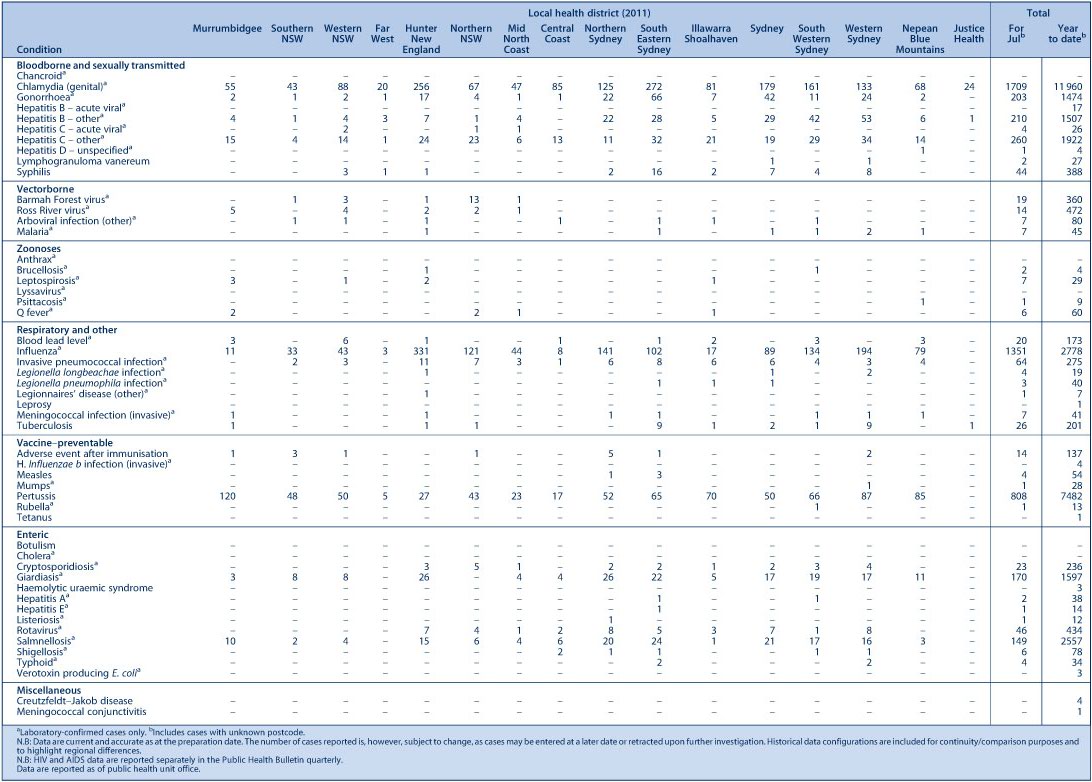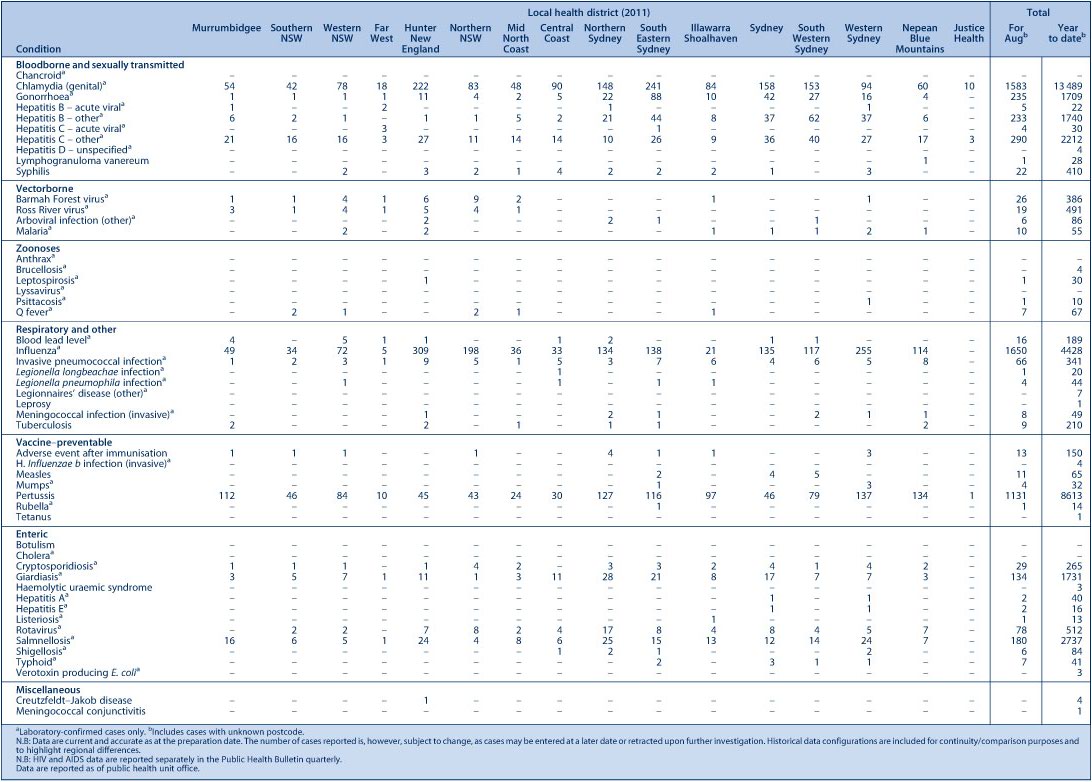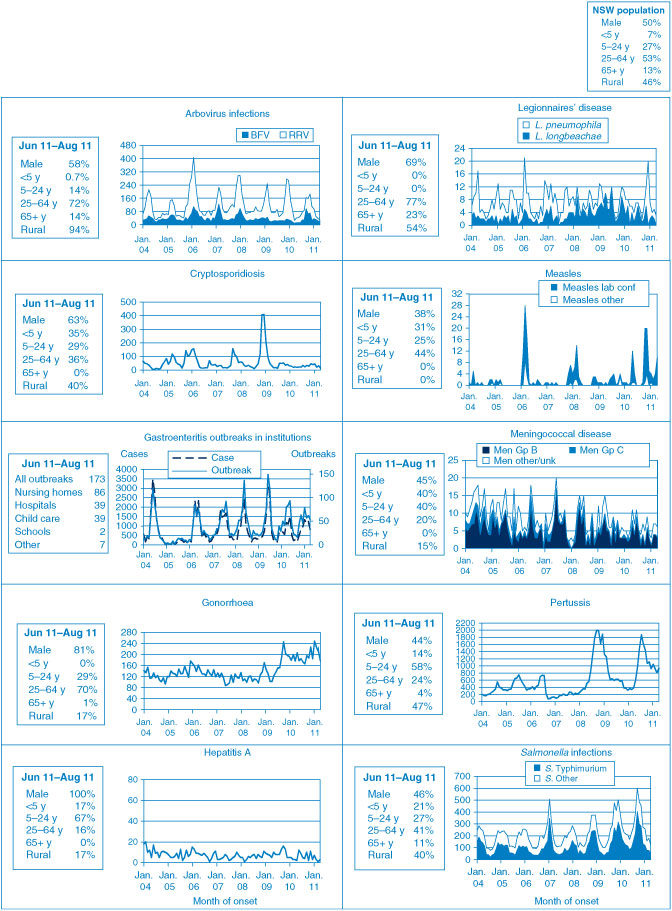Communicable Diseases Report, NSW, July and August 2011
Communicable Diseases BranchNSW Department of Health
NSW Public Health Bulletin 22(10) 210-215 https://doi.org/10.1071/NB11042
Published: 8 November 2011
| For updated information, including data and facts on specific diseases, visit www.health.nsw.gov.au and click on Public Health and then Infectious Diseases. The communicable diseases site is available at: http://www.health.nsw.gov.au/publichealth/infectious/index.asp. |
Figure 1 and Tables 1 and 2 show notifications of communicable diseases received in July and August 2011 in New South Wales (NSW).

|

|
Enteric infections
Outbreaks of foodborne disease
Sixteen outbreaks of gastrointestinal disease thought to be due to consumption of contaminated food were reported in July and August 2011. One outbreak was identified through surveillance of laboratory notifications, 14 outbreaks were identified through complaints to the NSW Food Authority and one outbreak through the local public health unit. Nine of these outbreaks were further investigated and enough evidence was gathered on three to suggest that they were outbreaks related to food. In two of these outbreaks, the causative organism was identified as Salmonella enterica serotype Typhimurium; in the third, no causative organism could be identified.
The first outbreak linked to S. enterica serotype Typhimurium was identified through a complaint to the NSW Food Authority about a restaurant. Interviews found that three of four ill people had consumed a tiramisu made with raw egg. Interviews with other cases whose illness was caused by S. enterica serotype Typhimurium with the same molecular subtyping (multiple-locus variable number tandem repeat analysis [MLVA] pattern) identified in the initial complaint case, found an additional ten people who had become ill following the consumption of tiramisu at this restaurant. This brought the total of known ill from this outbreak to thirteen people.
The second outbreak caused by S. enterica serotype Typhimurium was identified through routine surveillance of laboratory notifications which detected four cases of S. enterica serotype Typhimurium with the same MLVA pattern clustered in a regional city over the same 4-day collection period. It was revealed through interview that the four people all developed gastrointestinal illness after eating sandwiches prepared with raw egg mayonnaise from the same local café.
Both of these outbreaks appear likely to have been caused by the consumption of products containing contaminated raw eggs. Due to the risk associated with potential contamination of raw eggs with Salmonella,1 the businesses in both outbreaks agreed not to serve raw egg goods unless they used pasteurised egg product. Thorough cooking of food kills Salmonella and it is therefore advisable to avoid consumption of raw or undercooked eggs, especially young children, elderly people and people with an immunosuppressive condition.
The third outbreak was identified through two complaints about the same restaurant to the NSW Food Authority. The complaints were from two separate groups of six people who ate at the restaurant on different days (eight days apart). Eleven of these twelve people reported gastrointestinal illness. Interviews with the twelve people revealed that the most common foods eaten by the eleven ill people were schnitzels, potato salad and gravy however no one food item was clearly linked with illness. Gravy was one of the most common foods eaten by the ill people, so samples of the gravy were analysed. The NSW Food Authority inspected the premises and found cleaning standards and temperatures to be satisfactory. No causative agent was identified in the food samples taken from the restaurant. Based on the incubation period of 12 hours and symptoms of nausea and diarrhoea, the likely organism was considered to be a preformed bacterial toxin such as Clostridium perfringens or Bacillus cereus.
Outbreaks of gastroenteritis in institutional settings
In July and August 2011, 117 outbreaks of gastroenteritis in institutions were reported, affecting a total of 2145 people. Sixty-four outbreaks occurred in aged-care facilities, 25 in child-care centres, 25 in hospitals, and three in other residential and family-care centres. All these outbreaks appear to have been caused by person-to-person spread of a viral illness. In 80 (68%) outbreaks, one or more stool specimens were collected. In 49 (61%) of these specimens, norovirus was detected. Rotavirus was detected in nine (11%) outbreaks (norovirus was also identified in two of these). Adenovirus was detected in one outbreak. In 15 outbreaks all stool specimens were negative for pathogens. Stool specimens for laboratory testing were not available for the remaining 37 (32%) outbreaks.
Viral gastroenteritis increases in winter months. Public health units encourage institutions to submit stool specimens from cases for testing during an outbreak to help determine the cause of the outbreak. For more information on control guidelines for gastrointestinal outbreaks in institutions, see: http://www.health.gov.au/internet/main/publishing.nsf/Content/cda-cdna-norovirus.htm/$File/norovirus-guidelines.pdf
Zoonotic infections
Hendra virus
In July and August, Hendra virus was confirmed in ten horses on eight properties on the NSW North Coast. All horses died or were euthanised. Twenty-six potential human contacts of these horses were assessed by public health staff. Contacts were considered to be people who have had direct or indirect exposure of skin or mucous membranes to body fluids of a horse determined to be a confirmed case of Hendra virus infection, (or of a horse where heightened suspicion of infection exists on clinical and epidemiological grounds). Potential contacts were interviewed by public health staff about their exposures to the horse while it had symptoms and for the 3 days prior to onset of illness in the horse. None of the contacts were considered to have had high level exposure to infected horses. Queensland authorities also investigated outbreaks in this period.
Hendra virus infection is carried by all four species of flying foxes (fruit bats) in Australia. Occasionally the infection is passed to horses, presumably through exposure to virus excreted by flying foxes. There have been seven human infections with Hendra virus (including 4 deaths) identified in Australia to date, all following high level exposure to infected horses.2 No human infections have followed direct exposure to a flying fox or to another person with the infection.
Queensland and NSW government representatives have formed a Joint Government Hendra Virus Task Force which has met on several occasions. The Taskforce will recommend research into Hendra virus and transmission of the virus.
Respiratory infections
Influenza
The number of people who presented to 56 selected Emergency Departments with influenza-like-illness, and the number of notifications of laboratory-confirmed influenza remained stable in NSW during July and August 2011. There were 467 presentations (rate 2.6 per 1000 presentations) for July and 443 presentations (rate 2.3 per 1000 presentations) for August to selected Emergency Departments with influenza-like-illness. There were 1351 notifications of laboratory-confirmed influenza in July, and 1650 notifications in August.
A sample of 184 influenza A specimens collected from influenza patients from the Hunter New England area since May 2011 was tested for antiviral resistance. Of these, 25 influenza A (H1N1) 2009 specimens were identified with a mutation (H275Y neuraminidase) associated with resistance to two antiviral medications used to treat influenza, oseltamivir (Tamiflu™) and peramivir. Seven affected patients were hospitalised; there were no deaths. No patients had received oseltamivir or peramivir before the specimens were collected. None of these specimens showed resistance to the antiviral medication zanamivir (Relenza™).
For a more detailed report on respiratory activity in NSW see: http://www.health.nsw.gov.au/PublicHealth/Infectious/influenza_reports.asp
Vaccine-preventable diseases
Meningococcal disease
Fifteen confirmed cases of meningococcal disease were notified in July and August 2011. Ten cases were due to serogroup B, one serogroup W135, one serogroup Y, and, for three cases, the serogroup was unknown. Unusually, two serogroup B cases occurred one month apart in the same child-care centre in south western Sydney. The public health response after the notification of the first case followed national guidelines. Clearance antibiotics were provided to staff and children who were in the same child-care group as the case and information about meningococcal disease was provided to all parents of children at the centre. Following the second case, all children at the centre were offered information and clearance antibiotics.
A free vaccine for serogroup C meningococcal disease is available for infants at 12 months of age.3 Consequently, serogroup C disease is now mainly seen in adults and in unimmunised children. In NSW this year, 75% of cases of meningococcal disease where serogroup of the bacterium was known were caused by serogroup B, for which there is no vaccine. No cases of serogroup C disease have been notified to date this year.
Measles
Fifteen cases of measles were notified in NSW in July and August 2011. All cases lived in the Sydney metropolitan area and all recent cases have been acquired locally. As measles has not been endemic in NSW in recent years the original source case is presumed to have been an unidentified traveller who acquired measles overseas and who was infectious on their return to NSW. Four cases were children and eleven were adults aged between 19 and 37 years.
Many Australian-born people who are aged between 20 and 40 years may not have received any, let alone the two doses of measles vaccination that is required for best protection, and do not have immunity from past infection. Measles, mumps and rubella (MMR) vaccine is now routinely given at 12 months of age and again at 4 years (although it can be given from 3½ years); two MMR vaccines give long-lasting immunity.
An accurate immunisation history is often difficult to determine from adults who may be unsure of the exact details of the vaccines they received in childhood and do not have written records. There is no whole-of-life immunisation register that can be used to verify the vaccination record of adults. General practitioners are able to provide MMR vaccine free to anyone born after 1966 who has not received two doses of vaccine or who are unsure of their vaccination history.
References
[1] Heymann DL, ed. Control of Communicable Diseases Manual. 19th edition. Washington: American Public Health Association; 2008.[2] Selvey LA, Wells RM, McCormack JG, Ansford AJ, Murray K, Rogers RJ, et al. Infection of humans and horses by a newly described morbillivirus. Med J Aust 1995; 162 642–5..
| 1:STN:280:DyaK2Mzis12qsg%3D%3D&md5=0ca9c827bb5079ccafd77bbab725d98aCAS |
[3] National Health and Medical Research Council. The Australian Immunisation Handbook. 9th edition. Canberra: Australian Government Department of Health and Ageing; 2008.


